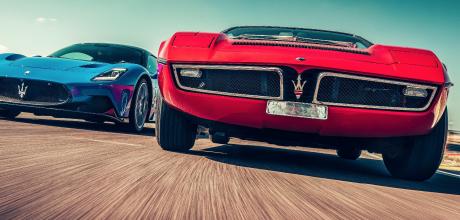Maserati’s glorious past, present and future
Who are you going to call when you need a Maserati-literate writer also able to beast an MC20 on track? Ben Barry, obviously.
So many glorious cars – and a few duds – have worn King Neptune’s trident on their grille. We drive seven of the most significant Maseratis
THE MAGIC KINGDOM
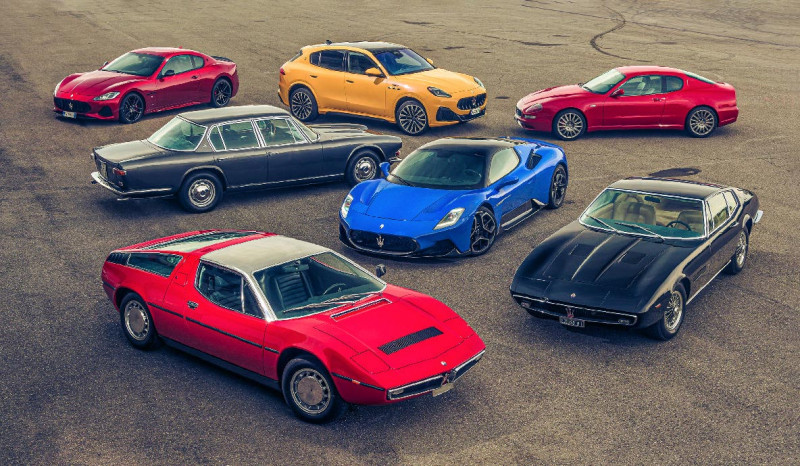
Maserati is rolling out a high-profile motorsport return to support its latest reinvention – Formula E to tell the electrification story, MC20 GT2 racing to say internal combustion isn’t dead – so it’s ironic that Maserati quitting motorsport in 1957 was the catalyst that allowed its road cars to flourish.
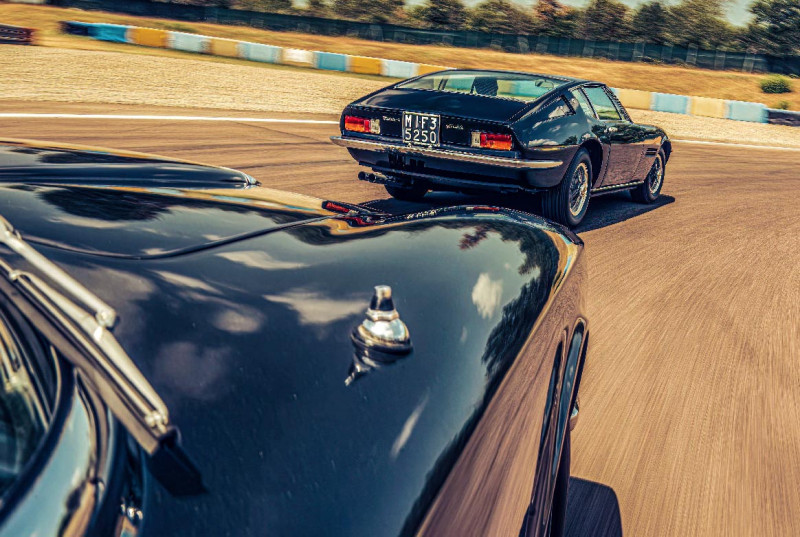
Today, at Autodromo di Modena where Maserati race-cars once roared, we’re celebrating key road-car milestones in a yarn that dovetails with CAR’s own six decades – innovations, turning points, changes of ownership, it’s all bound up in the seven cars that make other Italian brands look either one-dimensional or more coherent. A combination of events triggered Maserati’s motorsport exit only months after Fangio had clinched the 1957 Formula 1 title – a new Argentine government reneging on a machine-tools contract; revised F1 regulations for 1958 requiring extra investment – but a disastrous trip to Caracas in November while still in contention for the World Sportscar Championship with the 450S seems to have been the final straw for Maserati’s owners at the time, the Orsi family.
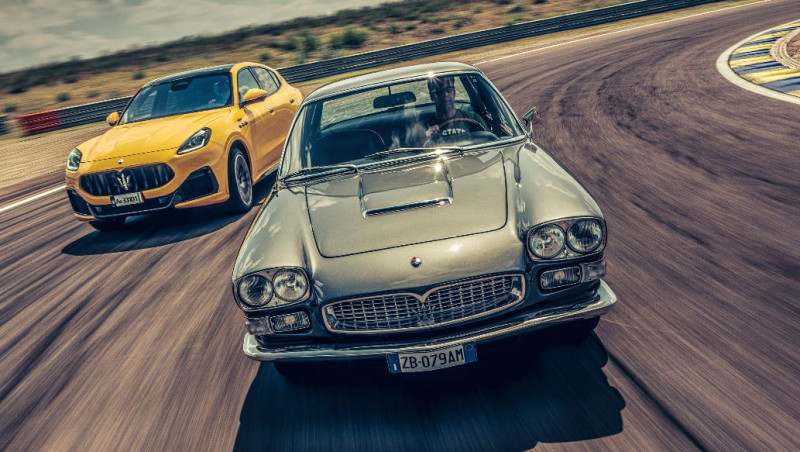
Thankfully the 450S’s oversquare 4.5-litre V8 lived on in a new generation of road cars. A version of the quad-cam motor bored to 5.0 litres first went in the 3500 GT-derived 5000 GT, but it’s the subsequent Quattroporte four-door saloon that’s more iconic and more widely produced. The latest car of that name is still the company flagship; it’s the thread that runs through the Maserati story.
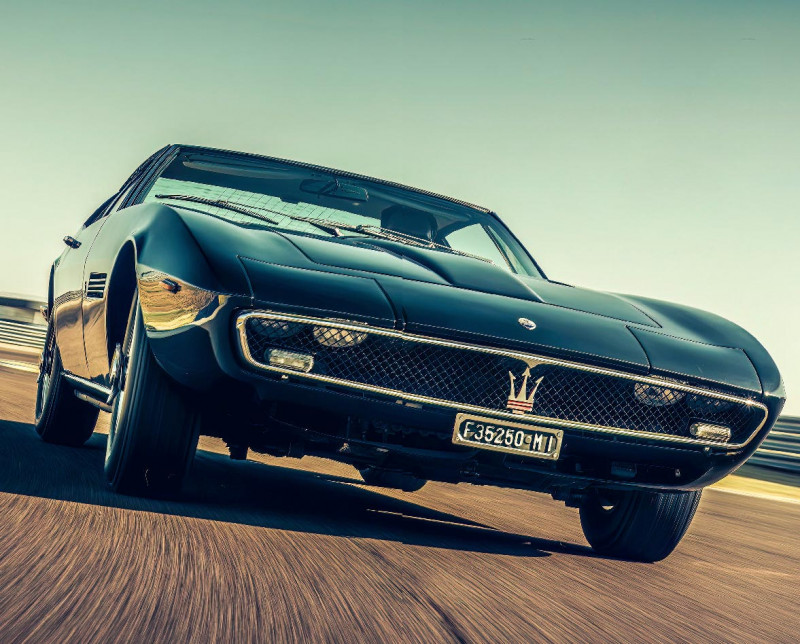
Built around a monocoque body, the gorgeous Frua-designed saloon derives from the Aga Khan’s coachbuilt 5000 GT coupe, with clean horizontal lines for the body and roof, a glasshouse defined by curvaceous front and rear screens, chrome trim that pings in the 32ºC sunshine and vestigial slivers of body-colour pillars. No wonder the five-metre-long limo made such an impact at the 1963 Turin show. You reach down low for the door handle but sit high and upright on leather front seats, surrounded by more leather, wood and chrome, the toggle switches and slender fingers of indicator stalks mixing with electric window controls and even very welcome standard-fit air conditioning. Smiths dials read to 300km/h for the speedo, the rev-counter marked with a 5500rpm redline.
The V8 – first reduced to a still-oversquare 4.1 litres for 256bhp, later offered with 4.7 litres and 286bhp for our gently facelifted second-series model – wakes with a cultured if powerful note, the clutch has a physical bite, but first gear slots easily and soon we’re easing down the pitlane. It’s an imperious experience, with a nicely controlled ride, effortless torque as we gather speed, and a thin wooden steering-wheel rim that has very little bearing on the QP’s trajectory initially, but its gentle rhythm suggests stability at speed more than sloppiness.
Handling is surprisingly tidy – the V8 is set so far back that you could almost put luggage in front – and apparently first-series models are sharper still, but road noise led Maserati to endlessly fettle the de Dion rear axle before a less sophisticated if quieter live axle replaced it.
Generous displacement lets the QP pick up its heels pretty keenly, pulling robustly from low revs and indulging a short-shift of the five-speed box with its relatively light and nicely defined action, but it also encourages you to explore the 5500rpm redline – there’s a stretch to this car’s character that’s logical given Maserati’s sporting past, if not entirely expected given the market segment.
In 1966 the Ghibli took the same basic engine and reprised the gran turismo formula more familiar to Maserati, but the two-door coupe that Giorgetto Giugiaro (working at Ghia) designed around a tubular chassis raised the bar, swapping stately understatement for a more streamlined body that flowed from a super-low nose – pop-up headlights and a new dry sump to lower the engine were key to that. You sit low in squishy seats, legs dead ahead despite the bulky transmission tunnel, your body louchly reclined, as if the performance is squeezing you back even with that smooth, cultured engine simply idling. It’s a sportier environment, with a roofline that tapers down behind the two seats to a plush loadbay, inviting you and a beautiful companion to load up matching luggage for a driving adventure.
The Ghibli’s V8 is boosted to 325bhp, there’s 120 fewer kilos to lug versus the QP, and this is a lower, sportier machine. Meatier steering that’s more direct and precise is the early scene-setter, but the ride is pleasingly supple, and while there’s some bodyroll, it’s actually very composed as weight loads up over outside wheels. The V8 feels more energetic and encourages you to wind it out to 5500rpm, but you’d need some nerve to uncork the claimed 175mph, 31mph more than the QP. At least these brakes feel matched to the tyres’ modest bite – they need a decent push but work well enough and don’t feel keen to lock. The Bora effectively replaced the Ghibli as Maserati’s flagship performance car in 1971 a few years after Citroën took a controlling stake, but it marked a radical departure. Maserati’s first mid-engined model, and first with fully independent suspension (double wishbones all-round), it was previewed around the same time as Giugiaro’s radical if visually comparable Maserati Boomerang concept, shortly after he’d established Italdesign.
What’s most striking isn’t the audaciousness of the wedgy design, it’s the Bora’s breathtaking beauty that a skilled designer could convey in three pen strokes – the horizontal swage line, a single line that rises and falls from the nose into the lower glasshouse to visually emphasise the cab-forward proportions, and how the swept-back windscreen appears to flow right into the tail – the illusion completed by a stainless steel roof that suggests a targa version might’ve been planned. Sitting on mirror-finished Campagnolo alloys, it’s achingly desirable, with clear echoes of Giugiaro’s later BMW M1 E26 and Alfetta GTV.
You recline on one-piece seats pushed right back against the bulkhead and dropped so low I still have two inches of headroom despite the Bora standing just 1134mm tall. The speedo and revcounter have pride of place ahead of the steering wheel, the stereo snuggles up against the driver’s door safe from passenger interference, and a centre console housing auxiliary gauges tilts towards the driver.
But for all the sporting focus, refinement was a key target. It’s why the mid-mounted V8 is also shrouded in carpet, so it’s a shame the promising driving position is compromised – the pedals are so offset it feels more like kite surfing than driving, and the steering wheel is wedged between my knees. Citroën hydraulics do at least let you tweak that seating position, adjusting pedals and steering wheel to suit the fixed seat decades before Ferrari played the same card with LaFerrari. They’re also used for the power-assisted steering and brakes.
At 1400kg the Bora is some 130kg lighter than a Ghibli, and the midengined layout makes this a far more reactive drive – liberated from the V8’s mass over the front axle, there’s lightness and delicacy to this front end, which dives into corners like a younger partner leading the older V8 behind on a romantic mystery tour with an outstretched arm.
The inevitable physics have the weighty V8 easing the rear end round during keen cornering, but it’s predictably benign, and while 306bhp is pretty generous, it’s modest enough that you can simply stand on the power in the dry and drive off down the next straight – it’s off-throttle rather than on that you’ll get into trouble, especially if you press the brakes. The Citroën set-up deadens the middle pedal, but it wakes so abruptly that locking is terrifyingly easy. It doesn’t help that the throttle is so loaded with initial tension for a similarly dead feel. Launched into the jaws of the oil crisis, the Bora was not a success, and while Maserati tried to salvage the concept with the similar Merak, which traded two cylinders for two extra seats, that car would be the last mid-engined Maserati (Enzo-based MC12 notwithstanding) until the current MC20.
Alejandro de Tomaso took control in 1975. During our visit, a longstanding employee recalls a culture of fear and micromanagement, noting that de Tomaso would dip a finger in oil and lick it when engineers were trying to identify engine issues. ‘He would say “Mmm, this is iron, this is steel” and the engineers would dip a finger in the oil and lick a different one and say “Yes, you are right!” he tells us. Few truly new cars were launched under de Tomaso’s control, but the feisty Argentinian did oversee a third Quattroporte, and introduced the Biturbo that has the look of an E30 3-series coupe knock-off – in fact, an exasperated Giugiaro handed Tomaso a re-touched E30 image with a trident on the nose before striding into the sunset.
When de Tomaso sold to Fiat in 1993, the similar-in-concept if largely new 3200 GT was the first car to launch, if not until 1998. The spec is promising, with double-wishbone suspension all-round featuring forged aluminium control arms and uprights, a potent V8 engine up front and a limited-slip differential helping 365bhp to the rear wheels. Giugiaro was even enticed back to pen a curvaceous design that signalled a clean break with the Biturbo era, but is most noted for its slender boomerang LED rear lights. The interior has a classic feel, with a centre console that flows into a heavily concaved instrument panel, and you sit low in comfortable seats, legs straight, steering wheel ideally contoured for a grip at quarter-to-three and steely gaze. Naturally there’s Fiat switchgear.
Turn the key and the deep-chested V8 burble does little to suggest the four-valve 3.2-litre motor is twin turbocharged, but you feel forced induction in the mush of the throttle and hear it in the whooshes and whistles that dominate quicker driving. Its 365bhp sounds punchy enough, but 1590kg takes the edge off, and the lag makes for such a long fuse you’re tempted to return to the firework.
This is the highly desirable Assetto Corsa limited edition, and while performance is unaltered, it does get uprated suspension, but there’s stoicism to the 3200 GT’s handling, with weight palpably front-biased, so that lifting the accelerator mid-turn simply reduces the tendency to understeer rather than introducing any real adjustability. It all feels a little stodgy on track, but it’s an easy car to drive – the steering mid-weighted, the gear shift fluid, the pedals far easier to dance over than the older stuff – so I imagine it’d satisfy at a gentler pace on the road. After Fiat-owned Ferrari took control of Maserati in 1999, it addressed some of the GT’s shortfalls with 2001’s Spyder, which featured a Ferrari V8 complete with a transaxle rather than a gearbox bolted to the back of the engine, and a shorter wheelbase. The next Quattroporte finally cut all ties with the de Tomaso era. Then, at the 2007 Geneva show, I remember watching the silk come off the Pininfarina-penned Granturismo, revealing a timeless design – just as well, given it’s only just left showrooms.
Based on a shortened version of the Quattroporte’s steel platform, there are references to 450S racer and Ghibli road car in these elegant lines, with the slinky bonnet emphasising how low and far back the Ferrari-derived 4.7-litre naturally aspirated V8 sits. We’re testing the Granturismo Sport, introduced in 2012 as a replacement for S variants – there’s a little more sporting focus but grand touring is still core.
A low driving position helps ensconce you in this cabin and the Ferrari motor wakes with an extravagant gargle, you select D and the Granturismo eagerly wafts away. It’s responsive without being oversensitive, with steering that twirls effortlessly yet brims with precision feedback, pedals that quickly yet smoothy ease you into the action, and a feeling that weight is located more centrally than the nose-heavy 3200 GT – Maserati in fact claims a slight rear bias. You feel confident and comfortable, the controls a natural extension of your inputs.
For a car that has to balance GT-appropriate comfort and refinement, the Granturismo Sport scores highly around the Autodromo – there might be a dearth of torque, with the full 383lb ft not clocking on until 4750rpm, but unleashing 453bhp at a sonorous 7000rpm is so much more intense and involving than short-shifting, sparky gearshifts keep the flow coming, and the relatively peaky characteristics mean you can lay into the power everywhere with satisfyingly big inputs rather than tip-toeing nervously.
Properly provoked there’s a nicely adjustable balance to exploit, with the Granturismo hanging at ridiculous angles with a nonchalance to make Bond look tightly wound, but mostly it’s a reassuring flow – strong bite at the front, excellent traction, dreamy steering and that ideal weight balance making it far more malleable than a 3200 GT through turns as well as more nimble than its 1880kg suggests.
If the Granturismo harks back to Maserati’s roots, the Grecale Trofeo fuses its high-performance heritage with a full-bore attack at the mid-sized SUV market. Maser’s second SUV, and aimed squarely at the Porsche Macan, the Grecale is based on a stretched version of the Alfa Romeo Stelvio’s Giorgio platform. ‘Trofeo’ means this is the most potent Grecale, and pretty serious it is too, with a version of Maserati’s new bi-turbo Nettuno engine pumping out 516bhp and 457lb ft, enough for 0-62mph in just 3.8sec and 178mph flat out.
The front sports seats’ lower bolsters are borderline uncomfortable to slide over as you climb aboard, but the pronounced lateral support is appropriate when you drop low into an overtly racey driving position – it’s an impressive cabin sprinkled with exposed carbonfibre weave, flashy Sonus Faber speaker grilles and contrast yellow stitching to match our car’s extrovert exterior. There’s also vastly improved tabletlike infotainment, loads of space in the back and a decent boot.
But the Grecale Trofeo delivers on track – the steering is quick, purposefully weighted and precise, the brakes bite firmly, and adaptive damping ably checks the body, helping to contain dive and manage weight transfer through quick flicks. It’s a secure base that invites you to delve fully into the V6’s generous performance and experience just how far turbocharging has come on since Maserati last went it alone – squeeze the throttle and there’s finger-click responses, a power curve that’s as happy to short shift as rush to 6500rpm, all of it complemented by a roaring soundtrack and thunderclaps for gearshifts.
This all-wheel drive’s smart too – get the nose settled and ease into the throttle and the Trofeo progressively powers out with a rear-biased push, so that you’re winding on steering lock to hold oversteer while gathering speed rapidly. Driven at eight tenths the Grecale is unflappable and highly engaging, but cracks surface when you push harder through these tight, late-apex curves – the all-wheel-drive’s instinct to claw grip combines with a pretty curt rebound action as the suspension chases two tonnes. It’s like tripping while sprinting but never quite faceplanting.
It makes me wish for a dedicated sports car, and handily there’s an MC20 idling nearby – a car that wasn’t even mentioned when I last visited Modena in late 2019 for a future-product briefing, Maserati now enjoying more freedom to do Ferrari-like stuff since Ferrari became independent of FCA and now Stellantis.
I open the butterfly door and fold myself rather awkwardly through a tight gap and into an otherwise nicely laid out if no-nonsense cabin – low-slung but highly comfortable seats, legs dead ahead, poor visibility through the Lexan rear screen magic’d away by a digital rear-view mirror. There’s leather and alcantara, but also teases of the carbonfibre tub developed with Dallara, to which forged aluminium double-wishbone suspension is attached front and rear.
The MC20 takes the V6 Nettuno engine, mounts it low behind the driver thanks to dry-sump lubrication, and bolts on an eight-speed dual-clutch gearbox. The engineers were briefed to halve the Enzo-based MC12’s cylinder and capacity count but match its output and blitz its torque – 621bhp and 539lb ft is mission accomplished. There’s a full electric MC20 due out next year, which could mean this one-size-fits-all chassis is a compromise, but purity is the more appropriate word. It’s the combination of lightness and deliciously adjustable balance that strikes you first – how easy steering swings the front into a corner light as a feather, and how the rear end will either dig in and mop up the power, or let you crank it completely out of shape as smoke curls from stressed rear tyres. It all depends how positive you are with that initial steering input and how late you dare stand on the excellent brakes, but the MC20 is a toss-it-in-now, sort-it-out later kind of supercar, which only encourages you to explore its sweetly balanced dynamics. The body’s beautifully controlled, weight transfer smoothed out, kerbs glossed over… lovely.
Its performance can’t match the fury of a McLaren or Ferrari but 2.9sec to 62mph and 202mph all in isn’t exactly lethargic, and there’s no shortage of muscle whether you’re hauling from a tight turn in a high gear or hanging on for 7500rpm, but I’m not particularly convinced by the guttural noise (more McLaren than Maser, and quite different to the Grecale), and there’s something a little hollow to its machinations – it’s technically effective, the gearshifts are startlingly punchy, and perhaps it adds a sense of weightlessness, but I’d dial in a little more mechanical integrity, a bit more grit.
Minor criticisms aside, on a memorable day of Maserati icons, the MC20 is the stand-out by a margin – something that feels both highly encouraging and slightly perplexing given how unlike a traditional Maserati it is both in concept and to drive. But, as these seven Maseratis ably attest, if any brand knows how to reinvent itself, it’s the Trident.
Ghibli was Giugiaro’s first Maserati, and one of his best
300MPH, THE SLOW WAY
A car maker unrivalled in its irrational pursuit of ultimates
The story so far…
Starting in 1909, Ettore Bugatti builds GP racers and luxurious touring cars in Molsheim, France. After he dies in 1947, the company grinds to a halt. In 1987 Romano Artioli fires up a new Bugatti, but it doesn’t last. In 1998 VW takes over and attempts to deliver CEO Ferdinand Piëch’s dream of an 18-cylinder luxury supercar. Several concepts later, the Veyron arrives, with 16 cylinders, then the Chiron. And in 2021 Rimac takes a controlling stake. Explain the ranking…
So much effort expended in search of unusable performance – 300mph in a Chiron! – at exorbitant cost. Bugatti in three words...
Money no object.
Best car...
The Type 35 from a century ago. Technically innovative, it wins more than 2000 races between 1924 and 1930. Darkest hour…
When Ferdinand Piëch quits in 2015, it’s only a matter of
time before cooler heads prevail and Bugatti exits the VW
Group, taking its massive financial losses with it.
The future looks…
Like someone else’s problem.
AS THESE SEVEN MASERATIS ABLY ATTEST, IF ANY BRAND KNOWS HOW TO REINVENT ITSELF, IT’S THE TRIDENT
MC20 and Bora from an erratic line of sports cars for the road Giugiaro in his straight-lined pomp with 1971’s Bora. One of today’s fastest SUVs meets one of the 1960s’ fastest saloons.
THE MC20 IS A TOSS-IT-IN-NOW, SORT-IT-OUTLATER
KIND OF SUPERCAR, ENCOURAGING YOU TO EXPLORE ITS DYNAMICS
NEVER A DULL MOMENT Always interesting, sometimes brilliant
TECHNICAL DATA MASERATI QUATTROPORTE
- YEARS BUILT 1966-1969 (Series II)
- POWERTRAIN 4719cc 16v V8, five-speed manual, rear-wheel drive
- PERFORMANCE
- MAX POWER 286bhp @ 5200rpm
- MAX TORQUE 268lb ft @ 4000rpm
- ACCELERATION 8.5sec 0-62mph
- MAX SPEED 144mph
- WEIGHT 1650kg
- EFFICIENCY 11.3mpg
TECHNICAL DATA MASERATI GHIBLI TIPO AM115
- YEARS BUILT 1966-1972
- POWERTRAIN 4719cc 16v V8, five-speed manual, rear-wheel drive
- PERFORMANCE
- MAX POWER 325bhp @ 5000rpm
- MAX TORQUE 333lb ft @ 4000rpm
- ACCELERATION 7.5sec 0-62mph
- MAX SPEED 175mph
- WEIGHT 1530kg
- EFFICIENCY 13.5mpg
BORA
YEARS BUILT 1971-1978
POWERTRAIN 4719cc 16v V8, five-speed manual, rear-wheel drive
PERFORMANCE
MAX POWER 306bhp @ 6000rpm
MAX TORQUE 340lb ft @ 4200rpm
ACCELERATION 6.8sec 0-62mph
MAX SPEED 175mph
WEIGHT 1400kg
EFFICIENCY 18.9mpg
3200 GT
YEARS BUILT 1998-2002
POWERTRAIN 3217cc 32v twin-turbo V8, six-speed manual, rear-wheel drive
PERFORMANCE
MAX POWER 365bhp @ 6250rpm
MAX TORQUE 362lb ft @ 4500rpm
ACCELERATION 5.5sec
0-62mph, 174mph
WEIGHT 1590kg
EFFICIENCY 16-18mpg
GRANTURISMO SPORT
YEARS BUILT 2012-2019
POWERTRAI N 4691cc 32v V8, six-speed automatic, rear-wheel drive
PERFORMANCE 453bhp @ 7000rpm
MAX TORQUE 383lb ft @ 4750rpm
ACCELERATION 4.7sec 0-62mph
MAX SPEED 185mph
WEIGHT 1880kg
EFFICIENCY 18.2mpg, 360g/km C02
GRECALE TROFEO
YEARS BUILT 2022-on
POWERTRAIN 3000cc 24v twin-turbo V6, eight-speed automatic, all-wheel drive
PERFORMANCE
MAX POWER 516bhp @ 6500rpm
MAX TORQUE 457lb ft @ 3000rpm
ACCELERATION 3.8sec 0-62mph
MAX SPEED 178mph
WEIGHT 2027kg
EFFICIENCY 21.0mpg
MC20
YEARS BUILT 2022-on
POWERTRAIN 3000cc 24v twin-turbo V6, eight-speed automatic, rear-wheel drive
PERFORMANCE
MAX POWER 621bhp @ 7500rpm
MAX TORQUE 539lb ft @ 3400rpm
ACCELERATION 0-62mph 2.9sec
MAX SPEED 202mph
WEIGHT 1475kg
EFFICIENCY 24.4mpg
WHAT’S MOST STRIKING IS THE BEAUTY A SKILLED DESIGNER COULD CONVEY IN THREE PEN STROKES
QP cracked the code: road car with a race-derived motor Trofeo version of Grecale updates the winning formula.Citroën-era Bora was Maserati’s first mid-engined road car Ghibli replaced Quattroporte’s glovebox with a passenger grab handle 3200 GT’s boomerang lights didn’t make it on to the 4200. Quattroporte and Ghibli; neither designed for the track. Still, since we’re here…
NEED TO KNOW
The story so far…
Founded by the Maserati brothers in 1914, the firm has known highs and lows like few others, and along the way has changed owners and changed direction several times, while producing the occasional classic racing car and pretty much inventing our idea of the GT. Explain the ranking…
Gloriously eccentric and unpredictable, Maserati is a car maker for romantics rather than a smart investment for pension funds. Maserati in three words…
Tony Soprano’s wheels. Best car… The Birdcage-inspired concept from 2005, built to mark long-time collaborator Sergio Pininfarina’s 75th birthday. Darkest hour… In the early ’70s, as oil prices rose, sales bombed, owner Citroën went bankrupt and Maserati went into liquidation. The future looks…
Rosy – if the mix of Grecale, MC20 and GT turns out to be a sales success. But if fresh turmoil descends, you can’t imagine current owner Stellantis indulging it for long.
Clock on the dash a Maserati motif for decades


